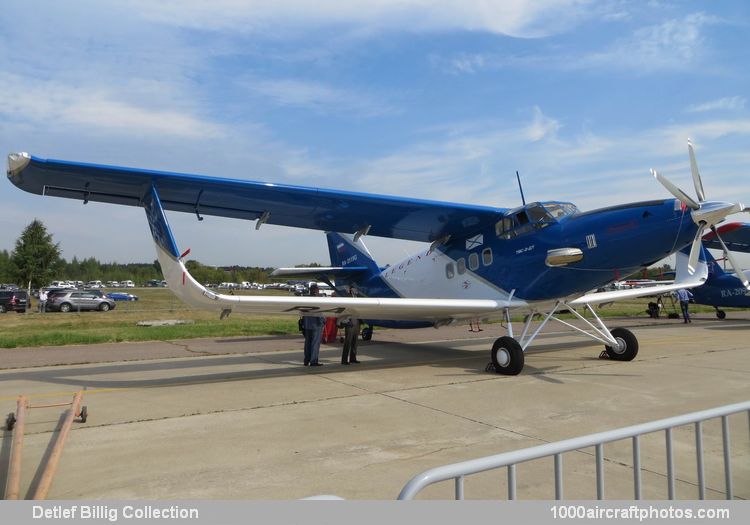06/05/2016. Remarks by Walter van Tilborg: "The two prototypes of what became the An-2 were designated SKh-1 and the first example made its first flight on August 31, 1947. The type was developed by OKB-153 (Design Bureau 153) which was later named after Oleg Antonov. The prototypes had a Shvetsov ASh-61, respectively ASh-62, radial engine with the latter being selected for production aircraft. The An-2 was built in large numbers in the USSR (Antonov), Poland (PZL/WSK Mielec) and PRC (Shijiazhuang) and production is claimed to have been over 18,000.
Over the years several efforts were made to improve the An-2 and several turbine engined versions have appeared.
ASTC (Antonov Aeronautical Scientific and Technical Complex) was the first to launch a turbine-powered variant. Design studies started in 1972 and in 1979 a photo was released of a modified An-2 (CCCP-30576) fitted with a 960 hp Glushenko TVD-10B turbine engine. Designated An-3, it was followed by a second test aircraft, now with a more powerful 1,430 hp Glushenko GTD-20. The upgraded variant was planned for production in several versions, but in the end no production aircraft were built.
The An-3T was more or less a revival of the An-3 and was developed by Omsk-based Polyot State Aerospace Enterprises, reportedly in co-operation with ASTC. The first An-3T made its maiden flight on February 10, 1998, powered by a 1,375 hp Omsk (Glushenko) TVD-20M turbine. The An-3T had several changes compared to the original An-3 such as the larger An-2M vertical tail, a extra partition between the cockpit and cabin, and was mainly intended for transport work, rather than as agplane. No new An-3Ts were built, but the twenty or so that were completed were modified from An-2 airframes which had sufficient structural life left. Plans for production of the An-3T in Poland were abandoned.
The An-3-300 designation was reported for a 2012 joint venture of Tyumen Plant No. 26 (Russia) and engine manufacturer Motor Sich (Ukraine) for a Motor Sich MS-14 turbine engine powered version. The joint venture fell through and instead the Antonov Company developed the An-2-100 which had a 1,500 hp MS-14 engine. A prototype first flew on July 10, 2013 and the upgrade was mainly aimed at the many An-2s that were still in operation in countries such as Belarus, Uzbekistan, Kazakhstan, Russia etc.
Another organization working on a "better" An-2 is SibNIA (Siberian Aeronautical Research Institute) in Novosibirsk, Russia. In this version, the An-2MS (An-2MC in Russian) and later usually referred to as the TVS-2MS), the radial engine was replaced by an 1,100 hp Honeywell TPE331-12UHR turbine, driving a five-bladed Hartzell propeller. The first An-2MS/TVS-2MS was first flown on September 5, 2011 and by 2015 well over fifteen examples had been delivered by SibNIA and Rusaviaprom JSC, all built, from existing An-2 airframes retaining the An-2 wings and tail feathers.
SibNIA went a step further and also developed an upgraded An-2 with an entirely new composite construction high-lift, high-aspect-ratio wing. This new wing was first tested on an An-2MS which flew as a high wing monoplane. The aircraft, designated TVS-2-DT, first flew in December 2014 and had the TPE331 engine and old style tail. It then received curved wing tips on the upper wing and a new lower wing with wing tips acting as interconnecting struts. In this guise it flew on June 10, 2015, initially also with the old tail, but this was soon replaced by a new design larger and squared vertical tail as shown in the photo."
